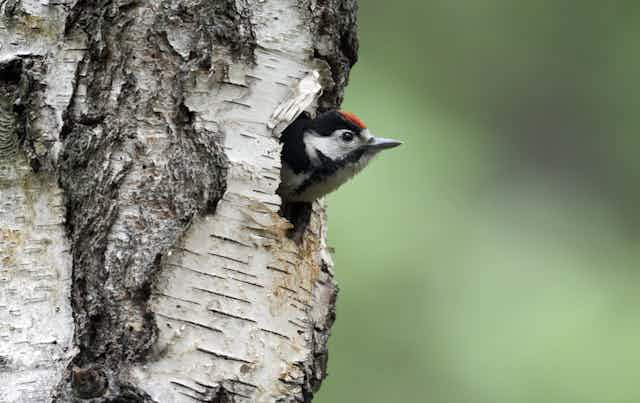England’s new environmental policy, biodiversity net gain, went live on February 12. Most new developments – everything from a few houses to large solar farms or new roads and railways – will now have to provide a 10% net gain in biodiversity, maintained for at least 30 years.
The idea is that, instead of driving a loss of habitats for wildlife, developments will now contribute to a recovery. The new policy will be rolled out to small sites in April 2024 and nationally significant infrastructure projects in 2025. Scotland and Wales are considering adopting similar policies.
It’s an exciting moment – we are academics who assess policies like these, and we recognise that this is one of the world’s most ambitious ecological compensation policies.
But our research has nonetheless identified flaws and loopholes. It will be important to get the nuts and bolts right to ensure the policy delivers real benefits, and that gains are not just made on paper.
What does a ‘biodiversity net gain’ actually mean?
The policy is designed so that the improvement is measurable using the statutory biodiversity metric. This is a calculation tool which assigns numerical values (“units”) to habitats based on their size, type and ecological condition. A small lawn might be one unit, while a small patch of woodland could be 16 units.
Before the bulldozers arrive, developers will need to take stock of the units provided by their on-site habitats. When the work is completed, there will need to be at least 10% more units than there were to begin with.

This should be achieved, firstly, by avoiding damage to the existing habitats as much as possible. But some harms are inevitable, and these will need to be compensated for – both by improving the quality of the remaining habitats, and by creating new habitats.
Habitats created in the same local authority as the damaged sites are awarded more units, reflecting a preference for keeping biodiversity local to the habitats and people affected by the development. In practice, this means the net gain rules generally promote more grassland, ponds, hedgerows and other natural habitats within developments. When on-site habitats are not enough to meet the 10% requirement, then off-site gains (“offsets”) can be purchased.
It is hoped that the developers’ demand for offsets will drive investment into landowners and habitat banks to do large nature recovery projects. This could allow, for example, the creation of wildflower meadows to offset the environmental harms caused by a new housing development.
Researchers have learned a lot about the outcomes of biodiversity net gain from studying councils such as West Oxfordshire and Cornwall, where equivalent commitments were adopted early. But based on this experience, academics and ecologists are still concerned about several key gaps in the policy.
Is it delivering for wildlife?
A key concern is that the metric used to score biodiversity may not work in the best interests of wildlife – particularly insects. The metric is intended to be a practical proxy for biodiversity, by assessing and scoring different habitat features. However, it assigns a low score to grasslands with nettles, ragwort, thistles and diverse mosaics of scrub and bare earth, which support a wealth of insect species.
Under the net gain policy, these habitats are penalised in favour of tidy grasslands that may have plenty of flowers but lack the other components necessary to sustain flourishing insect populations.

Not only will habitats potentially be worse for wildlife, but they will also be smaller, as our team’s recent research found that biodiversity net gain was associated with a reduction in the area of open greenspace. This is because the metric allows large “poor” quality habitats to be traded for small “good” ones.
We also found the metric is so flexible that most large developments can meet their entire 10% commitment within the development footprint. This reduces the demand for offsets, and hence the private investment that could be going into large nature recovery projects.
How will it be enforced?
Biodiversity net gain also allows developers to effectively trade existing habitats for promised future habitats. This is a big risk. For this trading system to work, it needs to be well monitored and governed, or else developers will have little incentive to actually create those new habitats.
Habitats promised on site – new ponds, lawns and so on – are at particular risk, as there are limited mechanisms to tackle non-compliance. Our team has previously estimated a quarter of habitat units promised under net gain regulations could be unmonitored and effectively unenforced.
In response to these challenges, the government has increased funding and powers for local planning authorities. However, there are still concerns that this won’t be enough to monitor habitats over 30 years and act against noncompliance.
There are also challenges with ensuring that habitats in the built environment have benefits for wildlife. This includes residential gardens and public-use grasslands which count toward the net gain requirement. Both will be well used by people and pets, reducing their wildlife value. For gardens, it is not yet clear how their wildlife value will be maintained and not lost to artificial grass, decking or concrete slabs.
As developers and planners get used to biodiversity net gain, we hope to see these gaps addressed in further policy tweaks. Biodiversity net gain is an exciting, ambitious policy, and we want it to achieve its full potential.

Don’t have time to read about climate change as much as you’d like?
Get a weekly roundup in your inbox instead. Every Wednesday, The Conversation’s environment editor writes Imagine, a short email that goes a little deeper into just one climate issue. Join the 30,000+ readers who’ve subscribed so far.

